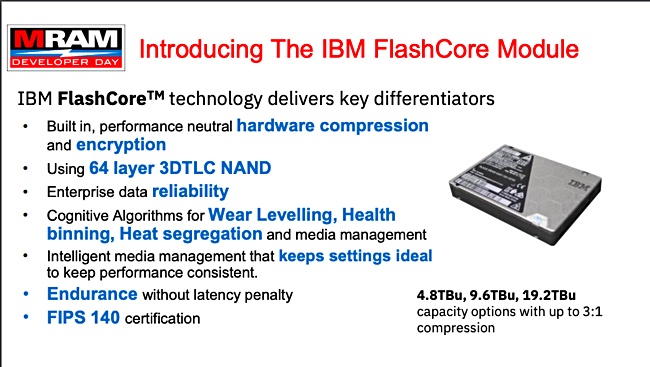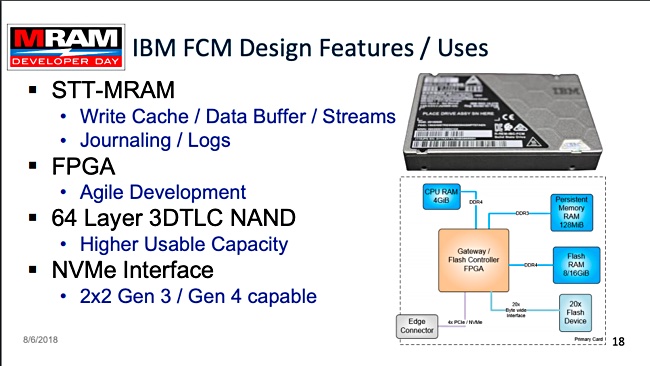IBM is using embedded Everspin MRAM to increase the capacity of its proprietary flash drives used in its Storwize and FlashSystem arrays.
Everspin CEO Kevin Conley said during an earnings call this week that IBM is using MRAM in the Storwize V5000, adding to the existing Storwize V7000 and FlashSystem arrays .
IBM described its use of MRAM in its FlashCore modules (drives) at an MRAM Developer Day event in August last year. The company said Storwize arrays used system-wide protection measures to write the contents of DRAM to flash storage if power failed.
The arrays used proprietary format FlashCore modules and IBM wanted to change these to standard format U.2 (2-5-inch) flash drives. The drives use its FPGA controller which puts incoming writes into DRAM. To protect that data against power loss the choice was between super-capacitors or MRAM.
Super-capacitors are relatively large whereas MRAM is small and permits more space inside the drive for NAND. It is almost as fast to access as DRAM at 35ns and has unlimited endurance. However, it is only available in small capacities, with 256Mbit chips in production and 1Gbit varieties in sampling. 256Mbit chip are large enough for write caching needs and the drives have 128MB of MRAM for this purpose.

The U.2 bandwagon
In April this year IBM introduced its U.2 format FlashCore drives with 4.8TB, 9.6TB and 19.2TB capacity levels, using 64-layer TLC (3bits/cell) 3D NAND and the Everspin MRAM write caches.

They are used for write cacheing plus journalling, logs, data buffering and streams in IBM’s Storwize V5100, V7000 and FlashSystem arrays.
The V5100 arrays have NVMe-connected FlashCore drives, using PCIe gen 4 x4 and support NVM-oF host access. The drives can configure the 4 PCIe lanes into a 2+2 scheme for dual-port access.
IBM capacity advantage at risk
The 19.2TB FlashCore module capacity is higher than many other SSD suppliers.
For example, Micron’s 9300 Pro tops out at 15.56TB using TLC flash, as does Western Digital’s Ultrastar DC SS530. However, Samsung has introduced a 30TB PM1643 SAS drive which blows IBM’s capacity advantage away – so long as you don’t need NVMe access. The same is true of Toshiba’s 30TB PM5, also a SAS interface drive.







